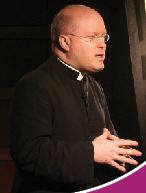 Let’s get right to what Pope John Paul II explains that Christ did, when He was asked about the meaning of marriage. We read in St. Matthew’s Gospel (Ch 19:3-9) that some Pharisees asked Jesus, in order to test Him, “Is it lawful for a man to divorce his wife for any reason?” He answered, “Have you not read that the One who made them at the beginning, made them male and female? For this reason, a man shall leave his father and mother and be joined to his wife, and the two shall become one flesh. They are no longer two but one flesh. Therefore, what God has joined together, let no one separate.”
Let’s get right to what Pope John Paul II explains that Christ did, when He was asked about the meaning of marriage. We read in St. Matthew’s Gospel (Ch 19:3-9) that some Pharisees asked Jesus, in order to test Him, “Is it lawful for a man to divorce his wife for any reason?” He answered, “Have you not read that the One who made them at the beginning, made them male and female? For this reason, a man shall leave his father and mother and be joined to his wife, and the two shall become one flesh. They are no longer two but one flesh. Therefore, what God has joined together, let no one separate.”
They said to Him, “Why then did Moses give us the command to give a certificate of dismissal and to divorce her?” Jesus said to them, “It was because you are hard-hearted that Moses allowed you to divorce your wives but from the beginning it was not so. And so, I say to you, that whoever divorces his wife (except for reasons of unchastity) and marries another, commits adultery.”
We see exactly what Christ did when He was asked a question about marriage, especially regarding its indissolubility. He took marriage back to the way God made it from the beginning; man and woman as gift of themselves to each other. They are to become one flesh and no one is to divide what God has joined. The only reason divorce came into the world was because man’s heart had become hardened over the course of time, it lost what God had originally given it.
Let’s follow Pope John Paul II’s thought. In taking marriage back to the beginning, Christ showed us where we need to go and when Pope John Paul II started to analyze what Christ revealed about the beginning, he said that a few things were obvious; the first and most important thing, the foundation was that God created man in solitude, there was an original solitude. That original solitude was meant to teach man two things; first that he was different from all the creatures that God gave Adam the ability to name, in freedom and that there was no helper fit for Adam among all of creation.
Secondly, Adam was different from God. From his origin, man was meant to realize his need for another person; that he was incomplete in and of himself; that he needed to have some other person that he could relate to. We’ll discuss why in a second. It has something to do with the meaning of who the human person is as a gift, that he was meant to be able to give himself to somebody else but there was no one that he would truly, in a way in accord with his nature, give himself to. In that first original insight man was supposed to realize (this fact), and Adam did.
 Adam realized that it was “not good for man to be alone,” that he was made to give of himself to another; that creatures were unworthy recipients and that God was too high a recipient for him. So where do we go from there?
Adam realized that it was “not good for man to be alone,” that he was made to give of himself to another; that creatures were unworthy recipients and that God was too high a recipient for him. So where do we go from there?
That leads to what God Himself did. God, after having finished all of creation and each day pronouncing it good and good and good, after the creation of man and pronouncing it also good, He pronounced everything very good and then said: “It is NOT good!” It was not good for man to be alone, even if Adam had God all to Himself in the Garden, even though he was perfectly created in the state of grace; he was lonely, he needed to have a proper, fitting helper to allow him to become whom God had created him to be, by receiving his gift of self, and being able to give himself back.
God allowed Adam to fall asleep and out of that sleep, God formed Eve from Adam’s side. Why from the side? To symbolize their equality before God because they stand side by side in front of God. As I say sometimes when I teach about Theology of the Body, God didn’t choose to create Eve from Adam’s big toe-nail or from his armpit, or from something that would show some discordance or inequality in creation. In creating Eve from Adam’s side; flesh of the same flesh, bone of the same bone, they were meant to stand as equals before God. Eve was a fitting helper for Adam; who was finally able to rejoice in his humanity as “bone of my bones, and flesh of my flesh.”
He was finally able to learn how to love another person and in loving that other, could learn how to relate and love God in the created world that God had made for them and then, in that analogy of human love, he could also learn how to love God. That original solitude of Adam, of the human person without a fitting helper, was meant to lead to an original unity. This desire to give of himself in love to another person and original unity was expressed in a particular way through the body. That’s the third of the original experiences that Pope John Paul describes, first the original solitude which leads to the original unity and then original unity which leads to the meaning of original nakedness.
When we look in the book of Genesis, we see something very interesting: that Adam and Eve were perfectly naked with each other but unashamed. That when they looked at the other person’s body, they saw that body as a sign of the other person, also as a type of sacrament in the broadest way of looking at it: a sacrament meaning an external sign of an internal reality. When they looked at the naked body of the other person, they saw a sign of who that person was and part of that personality contained within that body.
What was that personality when you got down to its real core? That personality showed a nuptial meaning. A meaning that was meant to be spousal, (meaning to give oneself to another in the flesh and in the person), so that when Adam looked at Eve, he saw the gift of somebody, a neon sign crying out saying, “I am a gift for you” and also an invitation, a summons for Adam to give of himself in love over to Eve. And when Eve looked at Adam she saw the same two realities.
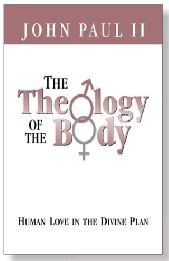 That original nakedness showed their immense trust for each other and, in relation to each other, they learned something about how they should also relate to God in love. In love of God, they were able to receive God’s gift of all creation and respond to it with the gift of themselves back to God. This meaning of the human person based on the nuptial meaning of the body was meant to lead to a communion of persons in love.
That original nakedness showed their immense trust for each other and, in relation to each other, they learned something about how they should also relate to God in love. In love of God, they were able to receive God’s gift of all creation and respond to it with the gift of themselves back to God. This meaning of the human person based on the nuptial meaning of the body was meant to lead to a communion of persons in love.
Pope John Paul said that the deepest theological insight that you can say about man and woman, the deepest insight of the Theology of the Body as a whole, is that man and woman are made in the image and likeness of God. Just as God is not only a mind that is rational but a Being with a will Who is free, man and woman were created with that rational aspect to them, and also that ability to choose freely. The deepest element of all was that man and woman were created together in the image of God and the communion of persons in love is meant to be expressed through the body that God gave man and woman. It is not just supposed to be expressed at the level of their will but in the level of their entire personality and expressed through the body.
That’s why the communion of persons is geared towards this one flesh union. Just as Jesus said in the beginning it was not so, God made them male and female for this reason: that a man should leave his mother and father and cling to his wife and they shall become one flesh. It’s in their becoming one flesh that the communion of persons is fulfilled and just like in God’s communion of persons, (demonstrating that the love between the Father and the Son is fruitful and how the Father loves the Son so much that Their love generated a Third Person), so too in marriage the love of man and woman can generate a third person who, like the Holy Spirit within the Trinity, is meant to be both a sign and an agent of their continued love.
So the nuptial meaning of the body, as expressed through the giving of one to the other and receiving the others’ gift, helps man and woman to fulfill his or her respective vocation. When we see what God reveals about marriage; we see Christ as God, revealing on the basis of His Own Identity as a Trinitarian communion of Persons in love, Father, Son and the Holy Spirit: who man and woman are supposed to be. That is expressed the most when they become one flesh, open to the life-giving aspect of their love together.
In order for them to love fully, they needed to be able to see all of this. In looking at the beginning of creation, Pope John Paul II says; “Man and woman were created in original innocence. There was purity in their vision; they shared in God’s own Holiness so that in looking at the other person, they saw a reflection of God. They saw not just the reflection of someone who was a summons to give of themselves, and someone who was a gift in person, but also someone who was a reflection of who God is as the Divine Giver.”
In looking at each other in original innocence (with purity in their hearts), they were able to see that the other person was able to bring them closer to God and to be a mediator of God’s love to them. They saw that God, as the Divine Giver, was giving of Himself in love through their love expressed for each other.
They were meant to be ministers, in essence, of God’s eternal plan of love, allowing them to enter into the mystery of Who God is; God Who is love, by their own love for each other. That purity of heart, that original innocence is what man today needs in order to be able to see man and woman with the fullness of that originally innocent vision. This is a vision that man has lost, which is why in the second of the seven aspects of the Theology of the Body, Pope John Paul II is going to take us back to what it means to be pure of heart, as He said in the Sermon on the Mount, “Blessed are the pure of heart, for they shall see God.”
Well, the pure of heart is able to see God in the other person, which is why marriage and love between man and woman is supposed to be beatific and is, when that originally innocent vision, that purity of heart, returns.
And we see there too, in that original innocence, in that purity of vision, who man and woman really are. When Adam looked at Eve, he saw not only a generic gift and a generic summons but also somebody who had a feminine aspect to that gift and a particularly maternal summons.
When Adam looked at Eve in all innocence, he saw someone who was feminine and a mother, when Eve looked at Adam, she saw someone who was both masculine and a father. Part of this acceptance of who the other person is, is going to be in accepting the other person in the masculinity and paternal meaning of his body and in the feminine and maternal meaning of her body.
What an incredible mystery contained there! So how did this come about? It came about as Pope John Paul II said, “in Biblical knowledge,” that the way Adam fully discovered who Eve was and vise versa, was when they “knew” each other, as Sacred Scripture says in a euphemistic expression to describe their conjugal union. This knowledge happened in the conjugal union and in that act, they became one flesh. Eve’s full femininity was revealed both to Adam and to herself, and Adam’s full masculinity was likewise revealed both to himself and to Eve.
How did that come about? In their union they revealed themselves in all their innocence to each other and there was a much deeper understanding of who they were called to be: a communion of persons. They learned who they were, in the nuptial meaning of the gift of their bodies to each other through the act of their physical union. And that masculinity and femininity expressed in conjugal union led to the blessing of a child. It led to a blessing of someone who was created to continue that image and likeness of God.
Adam and Eve in their communion of persons were able, through their love and God’s help, to give rise to another person who was to nourish that communion of persons by making that communion of persons grow.Forcing man and woman to come out of themselves even more and to prevent them from being tempted to make their own love selfish. And so that it would always fuse itself and overflow, they gave that love a name; that is what is meant to happen every time man and woman come together.
Man and woman know each other most fully, Pope John Paul II says, in a third person, sprung from them both, which is a revelation and a continual discovery of who they are themselves.
The child is a reproduction, in a sense, of this image of God which constitutes the continuous basis of their unity. A child can oftentimes keep a husband and wife much more close together in marriage and sometimes, prevent divorce. That is the way God made the child from the beginning, to be this continual source of their loving union.
When we see this loving union, it gives rise to the clear generative meaning of the human body, that the human body is meant to be fruitful; but fruitful in concert with the complementary gift of the other’s masculinity or femininity.
And that is what we can come to know most fully through this type of knowledge; any time that there is Biblical ignorance, this full revelation of the communion of persons is rejected. Then there is no real knowledge of who the other person is but a flight from the real truth of that person, in their masculinity or femininity.
In the first seven sections of the Theology of the Body, Pope John Paul II takes us right back to the beginning just as Christ did: who Adam and Eve are; who the human person is, originally made alone so that they might hunger for the presence of the other, that they might recognize their difference from the rest of creation and from God but then be able to rejoice in the union of persons together.
They are made to be a communion of persons in love just like the Blessed Trinity and that is expressed in the nuptial meaning of their bodies.
Their bodies are gifts for each other and a call to give of themselves to each other in their original innocence so that they can see each other purely in their generative meaning of that nuptial mystery; they are called to help each other be fruitful in and of the other person in love and finally, in this incredible gift of the Giver Himself, God gives them Himself ever more fully when they participate in this great mystery of their self-giving love to each other. In our next talk we will discuss how original sin invades this communion of persons.
Fr. Roger Landry
(...to be continued in the next issue)
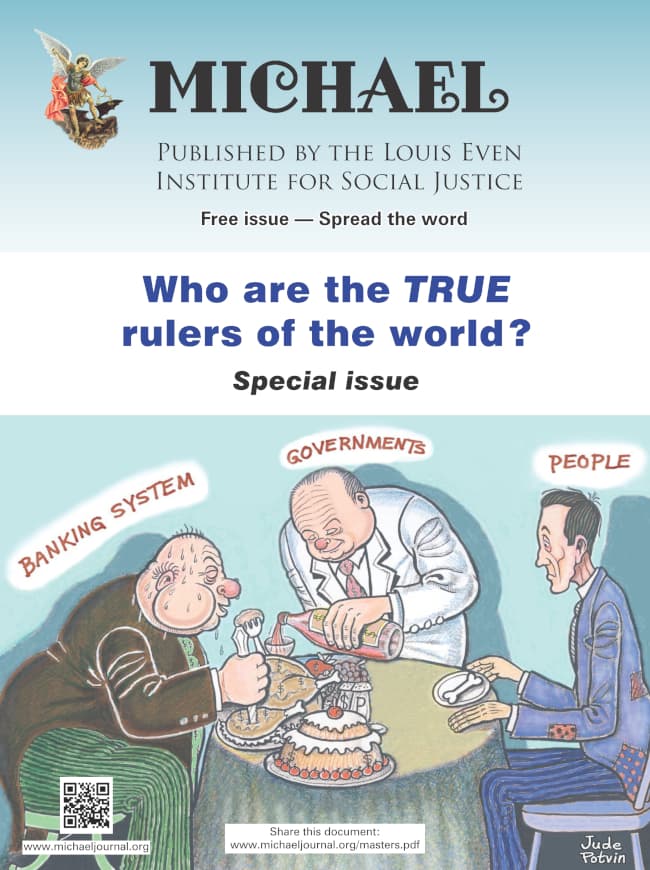 In this special issue of the journal, MICHAEL, the reader will discover who are the true rulers of the world. We discuss that the current monetary system is a mechanism to control populations. The reader will come to understand that "crises" are created and that when governments attempt to get out of the grip of financial tyranny wars are waged.
In this special issue of the journal, MICHAEL, the reader will discover who are the true rulers of the world. We discuss that the current monetary system is a mechanism to control populations. The reader will come to understand that "crises" are created and that when governments attempt to get out of the grip of financial tyranny wars are waged.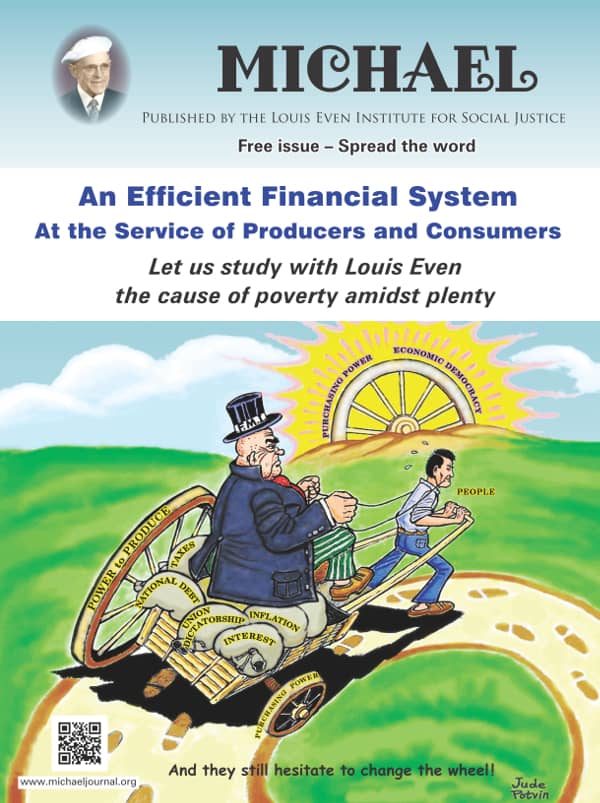 An Efficient Financial System, written by Louis Even, is for the reader who has some understanding of the Douglas Social Credit monetary reform principles. Technical aspects and applications are discussed in short chapters dedicated to the three propositions, how equilibrium between prices and purchasing power can be achieved, the financing of private and public production, how a Social Dividend would be financed, and, finally, what would become of taxes under a Douglas Social Credit economy. Study this publication to better grasp the practical application of Douglas' work.
An Efficient Financial System, written by Louis Even, is for the reader who has some understanding of the Douglas Social Credit monetary reform principles. Technical aspects and applications are discussed in short chapters dedicated to the three propositions, how equilibrium between prices and purchasing power can be achieved, the financing of private and public production, how a Social Dividend would be financed, and, finally, what would become of taxes under a Douglas Social Credit economy. Study this publication to better grasp the practical application of Douglas' work. 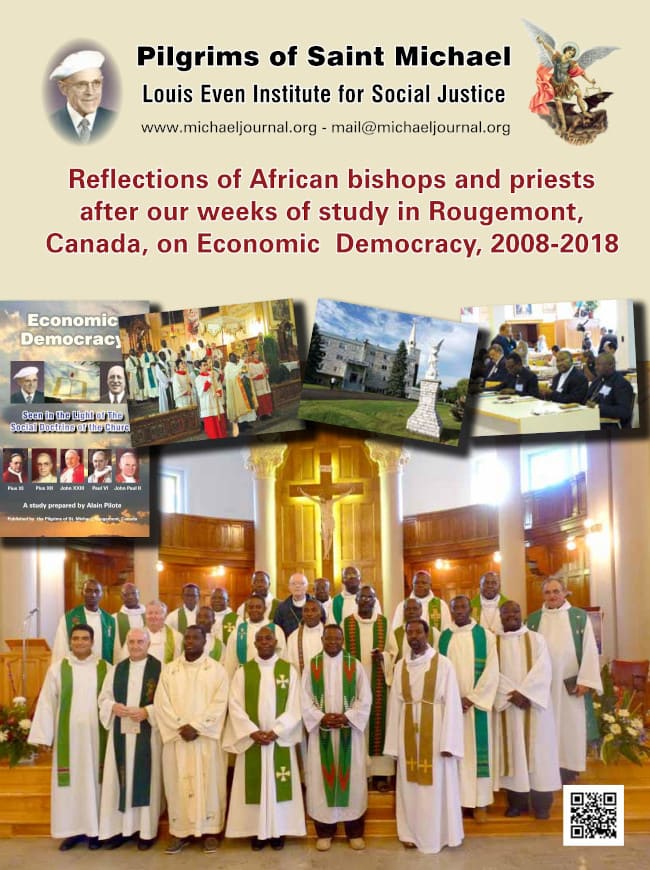 Reflections of African bishops and priests after our weeks of study in Rougemont, Canada, on Economic Democracy, 2008-2018
Reflections of African bishops and priests after our weeks of study in Rougemont, Canada, on Economic Democracy, 2008-2018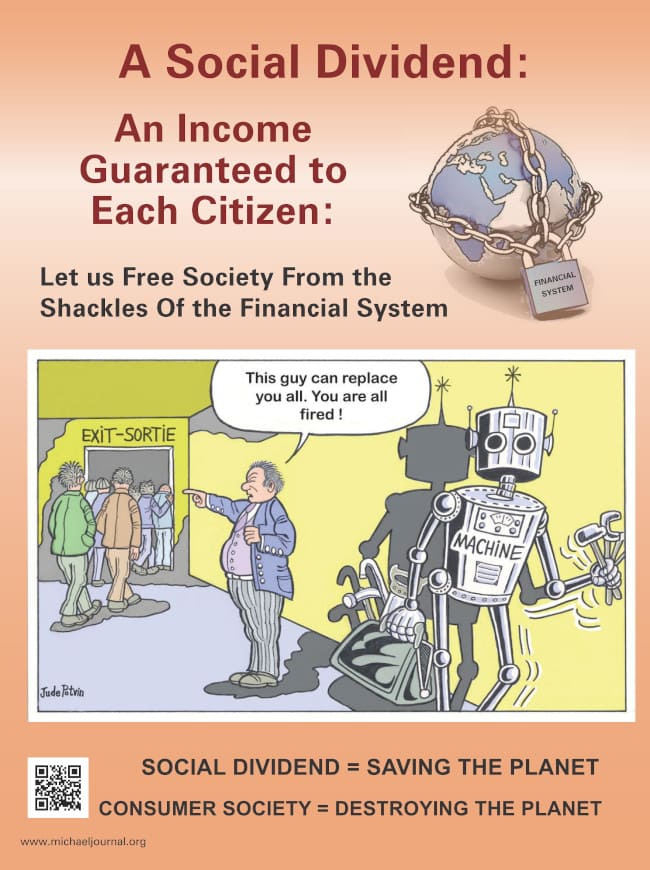 The Social Dividend is one of three principles that comprise the Social Credit monetary reform which is the topic of this booklet. The Social Dividend is an income granted to each citizen from cradle to grave, with- out condition, regardless of employment status.
The Social Dividend is one of three principles that comprise the Social Credit monetary reform which is the topic of this booklet. The Social Dividend is an income granted to each citizen from cradle to grave, with- out condition, regardless of employment status.Rougemont Quebec Monthly Meetings
Every 4th Sunday of every month, a monthly meeting is held in Rougemont.